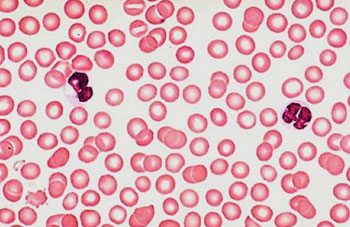Higher Histone Levels Associated with Thrombocytopenia
By LabMedica International staff writers
Posted on 09 Mar 2016
Thrombocytopenia is observed in approximately 30% to 40% of patients in the intensive care unit (ICU) concomitant with poor outcomes and an association with histones has been examined. Posted on 09 Mar 2016
Thrombocytopenia is a blood disease characterized by an abnormally low number of platelets in the blood and histones induce profound thrombocytopenia in mice and are associated with organ injury when released following extensive cell damage in patients who are critically ill.

Image: Photomicrograph of blood smear devoid of platelets from a patient with thrombocytopenia (Photo courtesy of the Icahn School of Medicine at Mount Sinai).
Scientists at the University of Liverpool (UK) carried out a case control study on included 56 patients with thrombocytopenia and 56 controls with normal platelet counts who were admitted to the ICU of the Royal Liverpool University Hospital (Liverpool, UK) between June 2013 and January 2014. Thrombocytopenia was defined as platelet count less than 150,000/103 µL or greater than 25% decrease or both with in the first 96 hours of admission to the ICU. Plasma histones were measured and daily levels and compared between the thrombocytopenic patients and non-thrombocytopenic controls.
The investigators found that histones circulated in the majority of thrombocytopenic patients and the histone levels were 2.5-fold to 5.5-fold higher than in non-thrombocytopenic controls. There was a significant association between high levels of histones at admission and subsequent decline in platelet counts among thrombocytopenic patients. High admission histone levels were associated with moderate to severe thrombocytopenia and development of clinically important thrombocytopenia.
The authors concluded that circulating histones are potential markers of disease severity, and the association with thrombocytopenia may reflect this. Nevertheless, the novel associations reported in the study extend previous reports demonstrating profound thrombocytopenia following histone infusion into mice and suggest that, if confirmed, circulating histones may be valuable in predicting or monitoring thrombocytopenia in patients who are critically ill.” The study was published on February 22, 2016, in the Journal of the American Medical Association.
Related Links:
University of Liverpool
Royal Liverpool University Hospital













